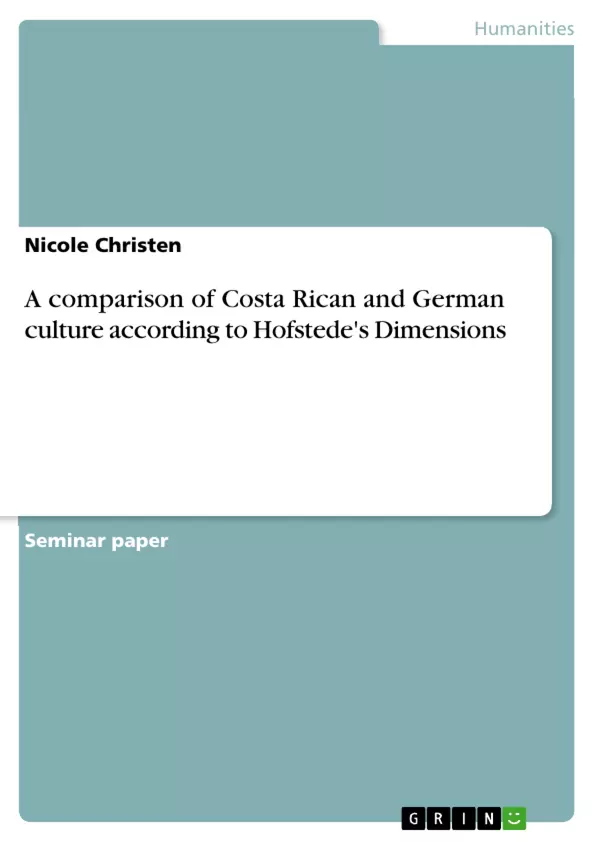Through this term paper, the reader is given an understanding of the Costa Rican and German culture and an instrument to play the Costa Rican and German social game.
In order to play the social game, it is advisable to take a closer look at the unwritten book and thus be able to understand the rules. Developing strong skills in communication and conflict resolution is increasing in value and importance due to an internationally linked world. For this reason, the topic of culture is addressed with a special focus on two contrasting societies. The aim is to show the reader some specific peculiarities of the Costa Rican and German culture.
First, the concept of culture is discussed. It will be explained what culture is and how it is created. Furthermore, it will be described how culture influences individuals and which role countries play in it. In the next step, the reader is introduced to Hofstede's six Dimensions of National Culture. These serve as a tool for classifying and analysing cultures and their values. It will be explained how Hofstede's dimensions were developed, what they mean and what values they represent. After the dimensions have been presented, Costa Rica´s and Germany's achieved scores are mentioned. Typical Costa Rican and German behavioural patterns, values and characteristics are then assigned to all dimensions. Then, an attempt to explain the achieved results is made on this basis. At the same time, it is intended to draw attention to the values lying behind the behaviours.
Table of Contents
- Abstract
- Introduction
- Culture
- Patterns, Mental Programs, Culture
- Developing Identities
- Culture and National Boarders
- Understand and Distinguish Cultures
- Hofstede's Dimensions of National Culture
- Power Distance
- Individualism
- Masculinity
- Uncertainty Avoidance
- Long Term Orientation and Indulgence
- Country Specifications - Costa Rica and Germany
- Costa Rica
- Germany
- Costa Rican and German Culture
- Power Distance in CR and GER
- Individualism versus Collectivism in CR and GER
- Masculinity versus Femininity in CR and GER
- Uncertainty Avoidance in CR and GER
- Summary
Objectives and Key Themes
This paper seeks to explore and analyze observations of Costa Rican and German culture, connecting them to Hofstede's Dimensions of National Culture. The goal is to provide the reader with a comparative understanding of these two societies.
- Defining the concept of culture and its impact on individuals and national boundaries
- Introducing Hofstede's six Dimensions of National Culture and their application in analyzing cultural values
- Examining the cultural values and behaviors of Costa Rica and Germany through the lens of Hofstede's dimensions
- Exploring the relationship between cultural dimensions and specific societal behaviors and characteristics
- Providing the reader with tools to navigate and understand cultural differences between Costa Rica and Germany.
Chapter Summaries
- Introduction: This chapter emphasizes the enduring nature of cultural identity despite societal change. It introduces the concept of "culture as the unwritten book" and the importance of understanding cultural rules for effective communication and conflict resolution. The chapter also outlines the paper's focus on Costa Rican and German culture.
- Culture: This chapter delves into the definition and creation of culture, exploring how it shapes individuals and the role of countries in its formation. It discusses the challenges of defining cultural boundaries and the importance of recognizing and respecting cultural diversity.
- Hofstede's Dimensions of National Culture: This chapter introduces Hofstede's six dimensions – Power Distance, Individualism, Masculinity, Uncertainty Avoidance, Long Term Orientation, and Indulgence – as tools for classifying and analyzing cultures. It explains the origins of these dimensions and the values they represent.
- Country Specifications - Costa Rica and Germany: This chapter provides an overview of key facts about Costa Rica and Germany, setting the stage for the subsequent analysis of cultural differences.
- Costa Rican and German Culture: This chapter examines how the cultural values and behaviors of Costa Rica and Germany manifest in relation to each of Hofstede's dimensions. It analyzes specific examples of observed behaviors and their underlying values.
Keywords
This paper focuses on the concepts of culture, national culture, Hofstede's dimensions, cultural values, Costa Rican culture, and German culture. It explores the relationship between these concepts through a comparative analysis of Costa Rican and German societies. This includes examining key characteristics, behaviors, and values that contribute to the distinct identities of these two nations.
- Quote paper
- Nicole Christen (Author), 2020, A comparison of Costa Rican and German culture according to Hofstede's Dimensions, Munich, GRIN Verlag, https://www.grin.com/document/933870



